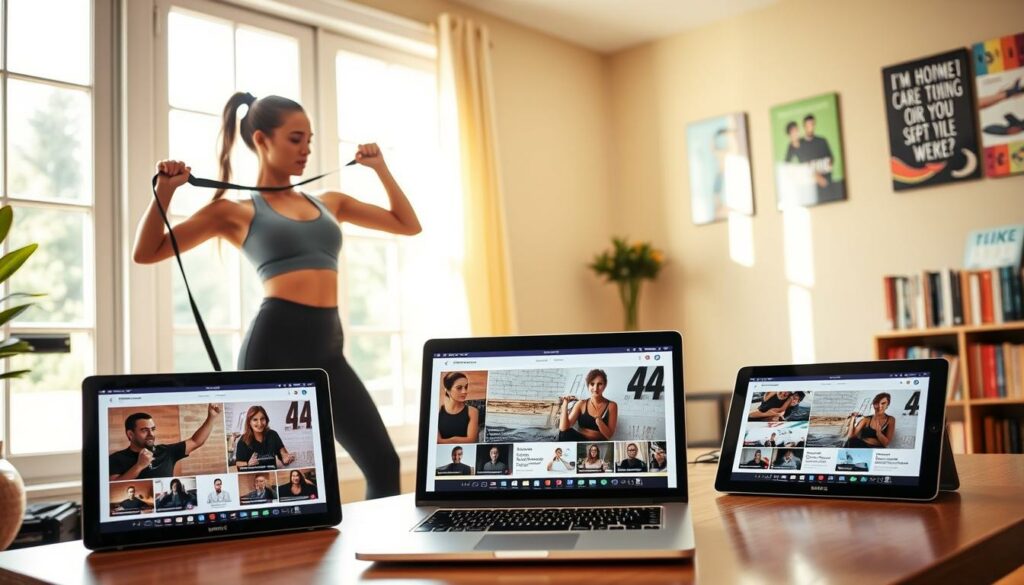Working out at home is easy and effective. It lets you keep up with your fitness goals without going to the gym. But, it can be hard to stay motivated without the gym’s structure.
With the right mindset and strategies, you can beat these challenges. Fitness at home is flexible and private. It lets you make a workout plan that fits your life and likes.
Knowing the ups and downs of exercise motivation at home helps. You can make a plan to stay on track. And enjoy the ease of working out in your own space.
Key Takeaways
- Home workouts offer flexibility and convenience.
- Creating a consistent routine is crucial for success.
- Understanding your fitness goals helps in staying motivated.
- A well-structured plan can help overcome common challenges.
- Staying motivated requires the right mindset and strategies.
The Benefits of Home Workouts
Home gyms are becoming popular, offering many benefits. People are choosing to work out at home for good reasons.
Convenience and Time Efficiency
Home workouts save time and are convenient. No need to travel to the gym. This means more time for other activities or more workouts.
They fit easily into busy lives. This is a big fitness benefit.
Cost-Effectiveness Compared to Gym Memberships
Building a home gym saves money over time. While it costs to set it up, it avoids monthly gym fees.
Privacy and Comfort Advantages
Home workouts offer privacy and comfort. You can wear what you like and feel comfortable. It’s different from public gyms.
Flexibility in Workout Styles and Timing
Home workouts are flexible. You can pick your favorite styles and schedules. Use online classes, fitness apps, or create your own routines.
Common Challenges of Home Workouts
Working out at home can be convenient, but it comes with its own set of challenges. Knowing these obstacles is key to finding ways to beat them.
Distractions and Interruptions
Home workouts often face distractions and interruptions. Family, pets, and chores can all get in the way. It’s hard to stay focused on your workout.
Limited Equipment and Space
Home workouts also struggle with limited equipment and space. Unlike gyms, homes often have less room and fewer tools. This limits the types of workouts you can do.
Lack of Community and Accountability
Working out at home can also mean missing out on gym community. Without friends to motivate you, it’s easy to skip workouts or lose interest.
Self-Motivation Hurdles
Self-motivation is a big challenge for home workouts. Without a gym’s structure, it’s easy to put off workouts or forget your goals.
| Challenge | Impact | Potential Solution |
|---|---|---|
| Distractions | Reduced focus and effectiveness | Create a dedicated workout space |
| Limited Equipment | Limited workout variety | Invest in versatile, multi-functional equipment |
| Lack of Community | Reduced motivation | Join online fitness communities |
| Self-Motivation | Inconsistent workout routine | Set clear, achievable goals and track progress |
Creating an Effective Home Workout Space
Creating a good home workout space needs careful thought. A well-designed area can boost your motivation and fitness journey.
Choosing the Right Location in Your Home
Finding the perfect spot for your home gym is key. It should be a quiet, dedicated area. Think about using a spare room, garage, or part of your living room. Make sure it’s well-ventilated and has a mirror for checking your form.
Essential Equipment for Different Fitness Goals
The gear you need depends on your fitness goals. For strength, consider dumbbells, resistance bands, or a weight bench. For cardio, a treadmill, stationary bike, or rowing machine might be best. Yoga mats and balance boards are great for flexibility and balance.
Budget-Friendly Space Setup Options
Setting up a home gym doesn’t have to cost a lot. Start with the basics and add more as you get better. Look for affordable options like second-hand gear or multi-functional equipment. Bodyweight exercises are also a great choice since they need no equipment.
Organizing Your Space for Maximum Efficiency
To make your home workout space efficient, keep it organized. Use shelves, bins, or racks for your equipment. Make sure your area is safe by securing equipment and having a clear path to leave.
Setting Realistic Fitness Goals
To stay motivated and focused, it’s key to set realistic fitness goals that match your health and wellness dreams. This means thinking carefully about both short-term and long-term goals.
Defining Short-term and Long-term Objectives
Short-term goals give you a quick win and boost your motivation. Long-term goals guide your fitness path and give it purpose. For example, a short-term goal might be to work out for 30 minutes, three times a week. A long-term goal could be to run a marathon in a year.
Creating SMART Fitness Goals
SMART fitness goals are Specific, Measurable, Achievable, Relevant, and Time-bound. This makes sure your goals are clear and reachable. For instance, a SMART goal might be “I will cut my body fat from 25% to 20% in 6 months. I’ll do this by exercising for 30 minutes, four times a week.”
Adjusting Goals as You Progress
As you get better, it’s important to check and change your goals. You might need to make your workouts harder or set new challenges to keep you going.
Balancing Ambition with Sustainability
It’s important to balance ambition with being able to keep it up. Setting too high goals can burn you out. So, aim for goals that are tough but doable in the long run.
Establishing a Consistent Workout Schedule
A well-planned workout schedule can greatly improve your home fitness journey. Being consistent is crucial for reaching your fitness goals. A schedule keeps you on track.
Finding Your Optimal Workout Time
Finding the best time to work out is important for a consistent routine. Some like morning workouts to boost energy, while others prefer evening to relieve stress. Try different times to see what fits your lifestyle and preferences.
Building Exercise Into Your Daily Routine
Make exercise a daily habit. Start by committing to a specific number of workouts per week. As you get more comfortable, increase the frequency. Link your workouts to daily activities, like right after waking up or after dinner.
Using Calendar Blocking for Workout Commitments
Calendar blocking helps you stick to your workout schedule. By treat your workouts as non-negotiable appointments, you avoid conflicts and prioritize exercise. Use a digital or physical calendar to mark workout times and set reminders.
Adapting Your Schedule During Busy Periods
Life can be unpredictable, and busy times are common. To keep up with workouts during these times, be flexible and adjust your schedule. Try shorter, intense workouts or exercises that need little equipment. The goal is to stay active, even if it’s not your usual routine.
How to Stay Motivated to Work Out at Home
Keeping up with a home workout routine needs the right mindset and motivation. It’s key to stay motivated, especially when working out at home. This helps you reach your fitness goals.
Creating a Compelling “Why” for Your Fitness Journey
Knowing why you started your fitness journey is crucial. Your “why” is the base of your motivation. It could be better health, getting ready for an event, or feeling more energetic.
Having a clear and strong “why” keeps you focused and driven.
Visualization Techniques for Motivation
Visualization is a powerful tool for motivation. It helps by imagining your fitness goals and how to achieve them. For example, seeing yourself finish a tough workout or hit a new personal best can motivate you.

Reward Systems That Actually Work
Using a reward system can help you stay motivated. Rewards can be things like new workout gear or a relaxing bath after working out. The important thing is to pick rewards that mean a lot to you.
Overcoming Common Motivation Killers
It’s important to know and beat common motivation killers. Things like distractions, feeling like you’re not making progress, and getting bored are common. Ways to beat these include having a dedicated workout area, setting achievable goals, and changing up your workouts.
| Motivation Technique | Description | Example |
|---|---|---|
| Creating a Compelling “Why” | Understanding your core reason for fitness | Improving health for family |
| Visualization Techniques | Mentally picturing your fitness goals | Imagining a successful workout |
| Reward Systems | Implementing rewards for milestones achieved | New workout gear after a month |
Leveraging Technology for Home Fitness
Using technology can make your home workouts more exciting and consistent. There are many digital tools and resources out there. They help make your home fitness routine more engaging and effective.
Fitness Apps That Boost Motivation
Fitness apps are a big help for those who work out at home. Apps like Nike Training Club, JEFIT, and MyFitnessPal offer lots of workouts and tracking features. They also have community support to keep you motivated.
These apps meet different fitness goals and tastes. So, it’s easier to find a workout that fits you.
Smart Equipment and Connected Devices
Smart equipment and connected devices have improved home workouts a lot. Smart treadmills, wearable fitness trackers, and resistance bands with sensors give valuable data. This helps users improve their workouts.
Brands like Fitbit and Garmin are leading in this area. They offer high-quality products that work well with popular fitness apps.
Virtual Reality and Immersive Workout Experiences
Virtual reality (VR) is changing home workouts by making them more immersive. VR fitness programs take you to new places, making workouts fun and engaging. This tech can make home workouts less boring.
Online Communities and Digital Challenges
Online communities and digital challenges help keep you motivated. Sites like Strava and Fitbit Coach let you connect with others, join challenges, and share your progress. This sense of community and accountability boosts your commitment to fitness.
| Technology | Benefits | Examples |
|---|---|---|
| Fitness Apps | Variety of workouts, tracking features, community support | Nike Training Club, JEFIT |
| Smart Equipment | Data tracking, personalized insights | Fitbit, Garmin |
| Virtual Reality | Immersive experiences, reduced monotony | VR Fitness Programs |
Tracking Progress Effectively
To stay motivated and reach your fitness goals, tracking your progress is key. It shows you what’s working and what needs work.
Fitness Metrics Worth Measuring
Choosing the right fitness metrics is important. They help you see how far you’ve come. Key metrics include:
- Workout frequency and duration: Keep track of how often and long you exercise.
- Weight and body fat percentage: Watch how your body composition changes.
- Exercise performance: See how your strength, endurance, or flexibility improves.
Apps and Tools for Progress Tracking
Many apps and tools can help you track your fitness. Some popular ones are:
- MyFitnessPal: Helps you track your nutrition and calories.
- Strava: Monitors your workouts and how well you’re doing.
- Fitbit: Tracks your daily activity and health.
Creating Visual Progress Records
Visual records like progress photos and workout logs are very motivating. They show your progress clearly over time.
Celebrating Milestones and Small Wins
Celebrating your achievements, big or small, keeps you motivated. Acknowledge your progress and treat yourself for hitting milestones.
By tracking your progress and celebrating your wins, you’ll stay motivated. This helps you keep moving towards your fitness goals.
Finding the Right Home Workout Programs
Finding the right home workout program is key to success. It must match your fitness goals and lifestyle. With so many online options, it’s important to choose wisely.
Evaluating Online Fitness Programs
When looking at online fitness programs, think about a few things. Check if they offer a variety of workouts and if they can be personalized. Also, make sure the trainers are qualified.
Look for programs that include different types of exercises. This ensures you get a balanced workout. You’ll need cardio, strength training, and flexibility exercises.
Free vs. Paid Workout Resources
Free and paid workout resources both have benefits. Free options are great for beginners, offering many workouts and basic content. Paid programs, however, provide more structure and support.
They often include personalized coaching and tools to track your progress. Think about your budget and goals when choosing between free and paid options.

Matching Programs to Your Fitness Level
It’s important to pick a program that fits your fitness level. Beginners need programs with basic exercises and a gradual increase in difficulty. More advanced people should look for programs with harder routines and higher intensity.
Variety and Progression in Workout Selection
To keep your workouts interesting and effective, mix things up. Choose programs that offer a variety of exercises. Also, look for programs that introduce new challenges regularly.
Building Accountability Without a Gym Community
Getting fit at home can be tough without a gym community. It’s easy to lose motivation and stop working out.
Virtual Workout Buddies and Groups
Finding virtual workout buddies or joining online groups helps a lot. These digital friends give you the push you need to keep going. You can find them on social media, fitness forums, or apps for home workouts.
Social Media Accountability Strategies
Using social media accountability is a smart move. Share your fitness journey on Instagram or Facebook. This way, you get support from friends, family, and online groups. Posting updates and using hashtags keeps you focused on your goals.
Working with Online Coaches and Trainers
Working with online coaches and trainers offers personalized help. They create workout plans, track your progress, and check in regularly. This personal support keeps you motivated and on track to reach your fitness goals.
Family Involvement in Your Fitness Journey
Getting your family involved in your fitness goals boosts accountability. Share your goals and invite them to join in on workouts or healthy activities. This creates a supportive home environment and promotes a healthier lifestyle for all.
Overcoming Motivation Slumps and Plateaus
Staying motivated at home can be tough. But, there are ways to beat the slumps and plateaus. First, know the signs of burnout and plateaus. This helps keep your workout routine going strong.
Recognizing Warning Signs of Burnout
Burnout shows up as tiredness, mental exhaustion, or no interest in working out. To avoid burnout, do the following:
- Listen to your body: Rest when you need to.
- Monitor your mental state: Look out for depression or anxiety.
- Vary your routine: Mix up your workout to avoid boredom.
Strategies for Pushing Through Plateaus
When you hit a plateau, it’s time to check your goals and plan. Here’s what to do:
- Increasing intensity: Make your workouts harder.
- Changing your routine: Try new exercises or styles.
- Seeking professional guidance: Get help from a fitness trainer.
When and How to Take Productive Breaks
Breaks are key for recovery and avoiding burnout. Use this time to:
- Reflect on your progress.
- Adjust your goals if needed.
- Plan a return to your routine with fresh motivation.
Refreshing Your Routine When Boredom Strikes
To fight boredom, add new things to your workout. Try virtual fitness classes or
By using these tips, you can beat motivation slumps and plateaus. This keeps your fitness journey on track.
Conclusion
Staying motivated to work out at home is key to reaching your fitness goals. This article has shared many ways to keep motivated and succeed with home workouts. Creating a good workout space, setting achievable goals, and using technology are all helpful.
Having a regular workout schedule and tracking your progress are also important. Finding the right workout programs and getting support from online buddies or coaches can help too.
By using these strategies and staying committed, you can achieve lasting success with home workouts. Focus on staying motivated, and you’ll be on your way to a healthier, more active life.
FAQ
What are the benefits of working out at home?
Working out at home is convenient and cost-effective. It offers privacy and flexibility. This makes it easier to keep up with your fitness routine.
How can I stay motivated to work out at home?
To stay motivated, find a compelling reason to start your fitness journey. Use visualization and reward systems. Overcome barriers to motivation with technology and tracking your progress.
What are some common challenges of home workouts, and how can I overcome them?
Common challenges include distractions and limited equipment. Create a dedicated space and a consistent schedule. Use strategies like calendar blocking and virtual workout buddies to stay on track.
How do I create an effective home workout space?
Choose the right location and essential equipment for your goals. Organize your space for efficiency. Use budget-friendly options and create a motivating environment.
What are some effective ways to track my fitness progress?
Measure key fitness metrics and use apps and tools. Create visual records and celebrate milestones. This helps you stay motivated and adjust your goals.
How can I find the right home workout programs?
Evaluate programs based on your fitness level. Decide between free and paid options. Choose programs that offer variety and progression.
How can I build accountability without a gym community?
Find virtual workout buddies and use social media. Work with online coaches and involve family. These alternatives help you stay motivated and committed.
What should I do when I hit a motivation slump or plateau?
Recognize burnout signs and use strategies to overcome plateaus. Take breaks and refresh your routine. This helps you stay on track with your goals.
How often should I adjust my fitness goals?
Adjust your goals as you progress. Ensure they are realistic and achievable. Regularly reviewing and updating your goals keeps you motivated and focused.
Can technology really help with home workouts?
Yes, technology enhances home workouts. Use fitness apps, smart equipment, and virtual reality. It boosts motivation, tracks progress, and keeps you engaged.


